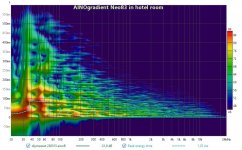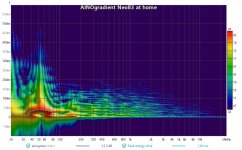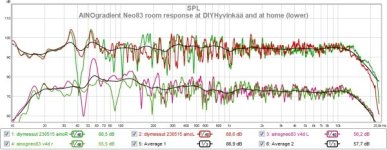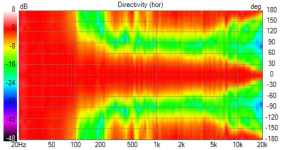Oh this is fairly close to full range. There is some attenuation on the midrange and the highs, but not a great deal.
So this is pretty close to a bipole. It just happens to be a bipole with DSP delay and attenuation on the rear, along with equalization of both speakers.
So this is pretty close to a bipole. It just happens to be a bipole with DSP delay and attenuation on the rear, along with equalization of both speakers.
Interesting point, I was already picturing how it would have to be arranged more or less in line with the source, like any cardioid array. This kind of boundary reinforcement is a problem in all kinds of settings. The passive solution is damping, but most people don't want to live inside of an acoustics laboratory, with diffusers and damping everywhere.
Active loudspeakers can use identical or similar drivers to control the direction of sound by controlling their phase to cancel or add in any direction or frequency. What would be required to decouple that further and cancel reflections from the room? Could it be accomplished with something smaller than a huge blanket on a wall?
The rear wall reflection I saw a page ago had data up to 10khz. I guess my thought was like a reverse surround sound setup, to cancel the room's reflection of the main system. I guess that's kind of like active noise canceling in an earbud. Infinitely easier once confined to the space of an eardrum versus the complexity of a room.
Though I think if the "rears" were in line with the main speakers, their reflection would more or less align, though it may not be as dispersed over space.
Active loudspeakers can use identical or similar drivers to control the direction of sound by controlling their phase to cancel or add in any direction or frequency. What would be required to decouple that further and cancel reflections from the room? Could it be accomplished with something smaller than a huge blanket on a wall?
The rear wall reflection I saw a page ago had data up to 10khz. I guess my thought was like a reverse surround sound setup, to cancel the room's reflection of the main system. I guess that's kind of like active noise canceling in an earbud. Infinitely easier once confined to the space of an eardrum versus the complexity of a room.
Though I think if the "rears" were in line with the main speakers, their reflection would more or less align, though it may not be as dispersed over space.
The bass itself can come from a box against the wall, since the radiation coincides due to the large wavelengths and becomes the reflection. The biggest problem with a box against the wall, IME, is the (eg) lower midrange due to the short distance around the cabinet and back to the wall x2.
yeah, highs are attenuated just by the bulk, roughly wavelengths smaller than the speaker box/construct are already something cardioidish. On the other end of spectrum lowest frequencies have wavelengths bigger than most rooms, ~30Hz is ~10m or ~30ft long. So, there is some bandwidth between the extremes, that is problematic as allenB notes.
As it's roughly roundtrip from cone to wall, and wall to ear, destructive interference happens when cone to wall distance is 1/4 wavelength, making the reflection be 1/2wl late from direct sound. This happens with increasing frequency until bulk of the speaker reduces sound toward the wall enough. So, cancelling sound toward wall behind speaker makes most sense here, roughly on bandwidth whose wavelength is longer than baffle dimensions, but shorter than cone center to wall distance x 4.
Now one can draw some simple geometry and start calculating. Typical 40cm dep box with 20cm wide baffle means roughly 50cm distance from cone center to wall, so first interference null is about 2m wavelength, ~170Hz or so. Since baffle is 20cm wide, it reduces sound toward wall roughly 20cm and up, this would be then be ~>1700Hz. So, cardioid makes sense at least here, roughly between 170-1700Hz. This is quite wide bandwidth.
If one does calculations like so the problematic area is the low mids give or take. And, try calculate what all your room boundary early reflections path lengths are, they all pile up on low mids. Same for box resonances, possible reflex port issues and so on So, cardioidish is not be all end all solution for loudspeakers, but at least something. It's most helpful if speakers need to be close to wall and listeming distance short (which lenghtens all other early reflections), and less usefull with speakers far from wall and listening far from wall, now all early reflections are more alike in delay, wall behind speaker being just one of six. Well, perhaps power response isnmore favorable and so on.
So, cardioidish is not be all end all solution for loudspeakers, but at least something. It's most helpful if speakers need to be close to wall and listeming distance short (which lenghtens all other early reflections), and less usefull with speakers far from wall and listening far from wall, now all early reflections are more alike in delay, wall behind speaker being just one of six. Well, perhaps power response isnmore favorable and so on.
As it's roughly roundtrip from cone to wall, and wall to ear, destructive interference happens when cone to wall distance is 1/4 wavelength, making the reflection be 1/2wl late from direct sound. This happens with increasing frequency until bulk of the speaker reduces sound toward the wall enough. So, cancelling sound toward wall behind speaker makes most sense here, roughly on bandwidth whose wavelength is longer than baffle dimensions, but shorter than cone center to wall distance x 4.
Now one can draw some simple geometry and start calculating. Typical 40cm dep box with 20cm wide baffle means roughly 50cm distance from cone center to wall, so first interference null is about 2m wavelength, ~170Hz or so. Since baffle is 20cm wide, it reduces sound toward wall roughly 20cm and up, this would be then be ~>1700Hz. So, cardioid makes sense at least here, roughly between 170-1700Hz. This is quite wide bandwidth.
If one does calculations like so the problematic area is the low mids give or take. And, try calculate what all your room boundary early reflections path lengths are, they all pile up on low mids. Same for box resonances, possible reflex port issues and so on
Last edited:
I’m trying to understand the appeal of cardioid in this use case vs using sound absorbing panels. I must be missing something.
Placing the out of phase “cardioid” speaker behind the “main” speaker produces a rearward null at whatever that 1/4 wavelength distance is. The strength of the cancellation decreases above/below that frequency. The wall behind the main speaker will produce an SBIR induced null at whatever frequency is associated with its 1/4 wavelength distance.
Compared to the distance between the main speaker and cardioid speaker, the wall will be farther from the drivers of the main speakers. That SBIR dip will then be lower in frequency than where the cardioid cancellation will be centered and thus the effectiveness of the cardioid dip at eliminating the SBIR dip will be reduced.
With that in mind, what does a cardioid design bring to the table when there are close (a couple feet) boundaries behind the speaker? It seems sound absorbing panels would likely be easier, cheaper, and more effective. Am I missing something?
Placing the out of phase “cardioid” speaker behind the “main” speaker produces a rearward null at whatever that 1/4 wavelength distance is. The strength of the cancellation decreases above/below that frequency. The wall behind the main speaker will produce an SBIR induced null at whatever frequency is associated with its 1/4 wavelength distance.
Compared to the distance between the main speaker and cardioid speaker, the wall will be farther from the drivers of the main speakers. That SBIR dip will then be lower in frequency than where the cardioid cancellation will be centered and thus the effectiveness of the cardioid dip at eliminating the SBIR dip will be reduced.
With that in mind, what does a cardioid design bring to the table when there are close (a couple feet) boundaries behind the speaker? It seems sound absorbing panels would likely be easier, cheaper, and more effective. Am I missing something?
IMO there is a lot of focus on front wall (in front of listener, behind speaker) reflections. To my mind the sound power and over-all directivity index is the benefit; reduced energy in the room for the same on-axis SPL must give cleaner sound akin to a reduced RT60 by absorption.
Yes, a di-pole will also give those benefits, but the di-pole pattern does not match typical tweeter and upper-mid driver dispersion patterns which is also usually cardioid on a baffle. And yes again, we could have a full-range di-pole but then we are back to a sound power issue this time in the mids and highs. Furthermore, most recordings are mixed and balanced for systems that are cardioid in the highs transitioning to omni in the lows. If we introduce a sudden change of dispersion pattern such as cardioid tweeter to di-pole mid we might find some tracks have a strange sounding balance or presentation (while others might be enhanced).
Yes, a di-pole will also give those benefits, but the di-pole pattern does not match typical tweeter and upper-mid driver dispersion patterns which is also usually cardioid on a baffle. And yes again, we could have a full-range di-pole but then we are back to a sound power issue this time in the mids and highs. Furthermore, most recordings are mixed and balanced for systems that are cardioid in the highs transitioning to omni in the lows. If we introduce a sudden change of dispersion pattern such as cardioid tweeter to di-pole mid we might find some tracks have a strange sounding balance or presentation (while others might be enhanced).
Yeah the whole room affects, a lot. Short story, my system has tweeters in waveguides and passive cardioid mids and is designed to be placed near wall. The sound seems balanced at home in away that it's been slowly developing for what it is as it's work in progress and I've got DSP to tweak and I'm happy with it. I took the set to a friends place the other day and while the positioning regarding wall behind speakers was the same as home the sound appeared immediately off, too bright. Even if all the other boundaries were further away, it's much bigger room there. Walls made of wood, lot less furnishing per naked boundary area, perhaps things I do not consider and so on, but the sound seemed obviously very bright there. Took quick measurement, used it as rough guide and tweaked by ear and got it better balanced, mainly backed of some PEQ I had in place, adjusted gains of ways perhaps db or so. I do not know what made it so, perhaps room modes make bass bit too warm at home, or something. It's just indication to me that "balanced setup" at one room doesn't necessarily sound the same on another, especially if it's DIY speakers as in my case  Even if it was cardioidish.
Even if it was cardioidish.
Takeaways are, perhaps my set has something wrong with it like my balancing for home relying on some early reflections / acoustics and was off from textbook, even if it's quite high DI system, which then made the sound balance off the wrong direction in the other place. Perhaps there is some distortion as I had to crank it bit louder there. That said, I left the DSP preset and am listening to it at home now and it sounds fine. Bit dark perhaps, but no problem. Toe-in and listening height are critical I think, those might have differed. Sketchy stuff overall and I really cannot overemphasize how important DSP is for DIY system development / experimentation. I'm not sure how much experience is needed to nail a passive system that worked great from the get go.
Takeaways are, perhaps my set has something wrong with it like my balancing for home relying on some early reflections / acoustics and was off from textbook, even if it's quite high DI system, which then made the sound balance off the wrong direction in the other place. Perhaps there is some distortion as I had to crank it bit louder there. That said, I left the DSP preset and am listening to it at home now and it sounds fine. Bit dark perhaps, but no problem. Toe-in and listening height are critical I think, those might have differed. Sketchy stuff overall and I really cannot overemphasize how important DSP is for DIY system development / experimentation. I'm not sure how much experience is needed to nail a passive system that worked great from the get go.
Last edited:
A quick and dirty experiment like you are trying should show you that cardioid will indeed tame that reflection from the front wall but then you have to get back to designing or choosing speakers for that space. Any number of commercial speakers with cardioid features are available if you have the budget or as proofs of existence of a solution. Rejection to the rear is the easiest thing to get. Seldom does it come with enough loss to the sides to reduce sidewall reflections more than a couple of db. OB, on the other hand will give you that, and if that space is as deep as it looks you should be able to pull the speakers far enough from the front wall for OB to work well. OB may also throw nulls at the ceiling. However, I think your high ceiling is a red herring as no reflections from it will be early. OTOH, I bet you have hellacious floor-ceiling modes in your bass!
Room has enormous effect on how a speaker sounds.
My AINOgradients are monopole in bass, cardioid low mid and dipole above 300Hz (see my avatar). When I was at a diy event in a hotel room, I was surprised how terrible the bass sounded. I had to reduce bass gain almost 10dB, and when they sounded "right", measured 500ms response was bass-shy. Room modes and decay look very different and reveal the huge difference. It was a very good "learn from mistakes" lesson! And still, my speakers were voted to have best sound!




Kii3 and D&D 8c are cardioid from roughly 100-150Hz up, and I think that it is the sweet spot. Low bass cardioid is waste of excursion and power with minimal benefits (at home)
My AINOgradients are monopole in bass, cardioid low mid and dipole above 300Hz (see my avatar). When I was at a diy event in a hotel room, I was surprised how terrible the bass sounded. I had to reduce bass gain almost 10dB, and when they sounded "right", measured 500ms response was bass-shy. Room modes and decay look very different and reveal the huge difference. It was a very good "learn from mistakes" lesson! And still, my speakers were voted to have best sound!




Kii3 and D&D 8c are cardioid from roughly 100-150Hz up, and I think that it is the sweet spot. Low bass cardioid is waste of excursion and power with minimal benefits (at home)
Last edited:
- Home
- Loudspeakers
- Multi-Way
- Cardioids for Dummies